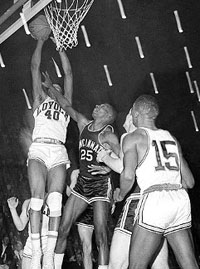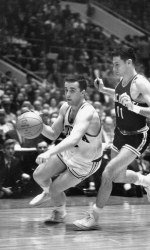CONTENTS
This is the first in a sequence of four related Snapshots.
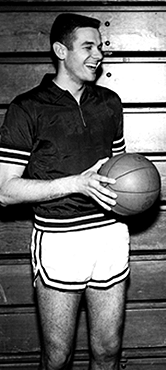 Bailey Howell |
Mississippi State basketball changed from a joke to SEC contender after
the arrival of James Harrison (Babe) McCarthy as coach in 1955. Basketball was so lightly regarded at MSU
that, as the story is told, an assistant football coach was once ordered to coach the basketball team at a reduced salary. (The
school had gone 31-15 in basketball in 1925-27 under football coach Bernie Bierman.)
McCarthy set about recruiting the best players in the area.
McCarthy made a more ambitious out of conference schedule for his second year.
|
- Admittedly the non-conference schedule was limited because of the state segregation law.
- By Howell's senior year, all the pieces were in place for a strong championship run.
- Kentucky met defeat in Starkville again, 66-58. The game essentially determined the SEC championship as the Maroons finished conference play 13-1 while UK was 12-2.
- However, at State's last regular season game, President Hilbun announced that the team would not participate in the NCAA tournament because of the possibility they would have to play integrated teams.
- So Kentucky became the SEC representative. Many years later, Howell said, "It was a bitter disappointment. But back then you didn't make waves. You accepted authority and went about your business."
MSU slumped to 12-13 (5-9 SEC) in 1959-60 in a rebuilding year but rebounded with a vengeance to capture the SEC title again in 1961 and 1962.
- However, in both cases there was no question the team would not play in the NCAA tournament.
- The team's star, W. D. (Red) Stroud, said: "We didn't give not going a second thought. When the SEC season ended, we turned in our shirts."
This is the second in a sequence of four related Snapshots. Part One is above.
George Ireland became the head basketball coach at Loyola University of Chicago in 1951. Ireland had been the star G and senior captain at Notre Dame when Ray Meyer, the future Hall of Fame coach at DePaul, Loyola's crosstown rival, was a sophomore. In his first nine seasons at Loyola, Ireland's record was only 107-106.
 Loyola Coach George Ireland with Ron Miller and Johnny Egan |
Ireland's first black star was Jerry Harkness, a 6'3"
New York City F who started play as a sophomore in 1960-61 when the Ramblers went 15-8 (after 10-12 the year before
when Harkness, like all freshmen in that era, was
ineligible for varsity competition). The following season, Harkness
was joined by Vic Rouse and Leslie Hunter,
both from Pearl High School in Nashville. Loyola
went 23-4 and won the NIT championship. When the team traveled to
New Orleans to play Loyola of the South, the black
players lived with black families while the white players stayed
in a hotel. The Ramblers clobbered the Wolfpack,
who were coached by former Rambler coach Jim
McCafferty, 95-73. Ireland's team had
a scary evening later that season in Huntington WV. After defeating
Marshall 88-80, the
Ramblers had to sneak out of a locker room back
door to avoid an angry mob. The next season, in Houston, the team
was spit on and ducked pennies thrown by spectators.
By 1963, Ireland added Ron Miller, a fourth African-American to the lineup. The only white was Windy City PG Johnny Egan. The Ramblers' up-tempo style that led the nation in scoring. People told Egan the team won because he, as the lone white, quarterbacked the team. Ireland was a stern taskmaster whom the players did not warm too. But the grueling practices allowed them to play all 40 minutes at a breakneck pace. Ireland also shielded the players from the hate mail and angry phone calls. George also was not popular with his fellow coaches. One coach told a banquet audience, "George Ireland isn't with us tonight because he's in Africa – recruiting." |
Continued below ...
This is the third in a sequence of four related Snapshots. Read Part One and Part Two above.
 Babe McCarthy with Bailey Howell (L) and Red Stroud (R) |
Babe McCarthy's 1962-63 Mississippi State squad
won the SEC championship for the third straight year. The squad
compiled a 22-5 regular season record and won 12 of 14 in the SEC,
including a 56-52 win in Starkville over
Kentucky, which finished an uncharacteristic
8-6 in SEC play. McCarthy's philosophy was simple:
get ahead, then spread the court (in a forerunner of the Four Corners
offense), and milk the lead.
As the season wound down, Babe campaigned for the university to break with tradition and allow the team to compete in the NCAA tournament. He didn't have to convince the student body, who overwhelmingly supported him. Five months earlier, the University of Mississippi had been torn apart by the enforced admission of its first African-American student, James Meredith. MSU President Dean Colvard, a North Carolinian who took the post in 1960, saw basketball as a way to prepare his campus for the inevitable integration. Shortly before the Maroons took the floor for their season finale at Ole Miss, Colvard issued a statement that the school would send the team to the post-season tournament "unless hindered by competent authority." |
The day before the team's scheduled departure for East Lansing MI, a chancery court judge issued an injunction to keep MSU from violating "the public policies of the State of Mississippi." Without knowing exactly who had been named in the injunction, Colvard gathered five school officials as well as McCarthy at a secret meeting on a dairy farm outside of Starkville and plotted a strategy to avoid the injunction. Colvard left early for a prescheduled speaking engagement at Auburn. McCarthy and AD Wade Walker took back roads to Memphis and flew to Nashville that night. All had fled the state by the time couriers arrived from Jackson with the writ.
Early the next morning, the team trainer drove the team's subs to the airfield in Starkville while assistant coach Jerry Simmons waited with the regulars on a private plane in nearby Columbus. When the trainer phoned to say that no injunction had been served, Simmons and the regulars joined the rest of the squad for the flight to Nashville where they picked up McCarthy and Walker.
East Lansing hailed the Maroons as heroes. (Ironically, "maroon" was an old Southern term for a runaway slave. Eventually, MSU began calling its teams "Bulldogs.") A local band would play for MSU in Jenison Field House. Meanwhile, a Mississippi supreme court justice threw out the injunction.
With all the uncertainty and disruption of normal practice schedules, how would the team fare against the Loyola Ramblers?
To be continued ...
This is the last in a sequence of four related Snapshots.
Part One | Part Two | Part
Three.
|
|
Mississippi State played Loyola of Chicago in the Mideast Regional in E. Lansing MI on March 15,
1963. This was MSU's first NCAA Tournament game ever as well as the school's first contest in any
sport against an opponent with black players. The Loyola coach, George Ireland, who liked to run up the score on Southern teams whenever he played
them, admired the Maroons for defying
state law and making the trip north.
After watching Loyola slaughter Tennessee State 111-42 in a play-in game (required since Loyola was an at-large team rather than a conference champion), State coach "Babe" McCarthy told the press: "I wish I'd stayed home. Nobody can beat a team like that." However, he told his team they could beat Loyola the same way they'd won at Kentucky the year before: get the lead, then run their delay offense. 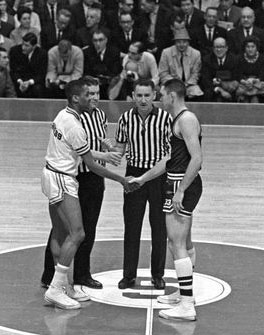 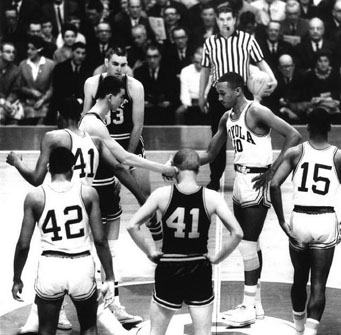 The captains shake hands (L) and the centers shake before the opening tip. Loyola's senior leader, Jerry Harkness,
one of four African-American starters for the Ramblers,
remembers all the flashbulbs going off when he shook
hands with Joe Dan Gold, the MSU
captain, before tipoff. McCarthy's
plan worked at first. The Bulldogs
used their delay game to take a 7-0 lead in the
first five minutes. Then Loyola adjusted defensively and played more patiently on
offense to move out to a 26-19 halftime lead. The Ramblers never relinquished the
advantage in a 61-51 triumph.
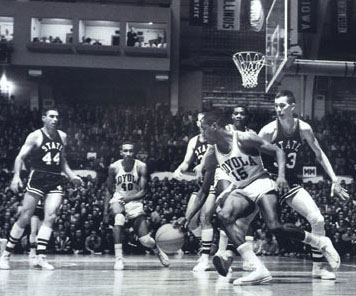 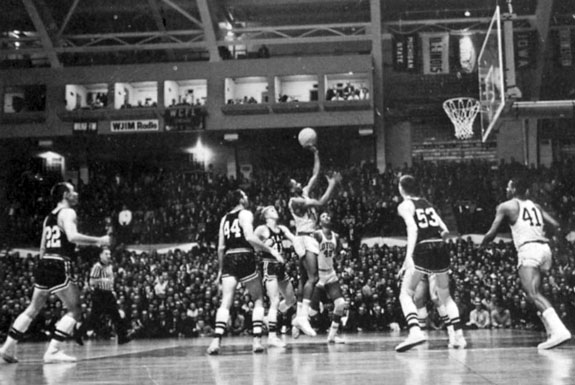 Harkness led all scorers with 20. Vic Rouse added 16, Leslie Hunter 12, and Ron Miller 11. All SEC F Leland Mitchell, who fouled out with six to play, topped MSU with 14. More importantly, despite the wariness of both squads, there wasn't a single instance of taunting or overly physical play. Mitchell helped Rouse up after the two went to the floor for a loose ball. 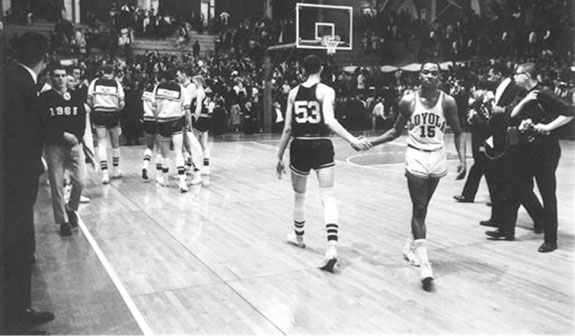 MSU's Stan Brinker shakes Jerry Harkness's hand after the game |
In those days, the losers of the first games at each Regional played a consolation game. Mississippi State defeated Bowling Green 65-60 despite 31 RBs by BG's All-American African-American C Nate Thurmond. When the Maroons returned to Starkville, cars lined up for 20 miles to welcome them home. As one of the MSU players, Bobby Shows, has said: "The K.K.K. boys were a nasty ugly minority. Most people weren't like that. And even though we lost, we came home as winners."
At the 2008 Final Four in Detroit, the NCAA sponsored a special screening of the documentary "Game of Change" that chronicles the Loyola–Mississippi State game.
|
This is the follow-up to a sequence of four related Snapshots above.
The 1963 NCAA title game between Loyola of Chicago and Cincinnati at Freedom Hall in Louisville has been called "one of the most memorable in tournament history." Reasons?
Making its first appearance in the NCAA tournament, Loyola was a decided underdog to Ed Junker's Bearcats, the two-time defending champions who were 82-6 the last three years. They were playing in an unprecedented fifth straight Final Four. The contest was a dream matchup in that Loyola led the nation in offense while Cincinnati was the #1 defensive team. As usually happens, defense prevailed before a sellout crowd of 19,153. The Ramblers had been led all season by senior F Jerry Harkness who had 29 points (8 above his season average) and 18 rebounds in the semifinal win over Duke the night before the final. However, the Bearcats held him without a FG until 4:29 was left in the game. Cincinnati built a 15-point lead with 11:45 to go. Partly because of foul problems, Junker decided to slow down the tempo. This turned into a fatal mistake as the Bearcats made only two FGs in the last 14 minutes of regulation. With their top scorer finally contributing and their furious press creating mayhem, Loyola fought back to trail 53-52 with 12 seconds left. Cincy's G Larry Shingleton made the first of a one-and-one but missed the second. This gave Harkness the chance to hit a 10-footer to tie at the end of regulation. If Shingleton had made the second FT, Cincinnati would undoubtedly have won since there was no 3-point shot then. The overtime started fast. Harkness got the tip and streaked to the basket for a two-point lead. Bearcat All-American George Wilson tied it with a "twisting, close-in shot." Ron Miller's 25-foot jump shot put Loyola up again with three minutes left but Tom Thacker hit Shingleton on a court-length pass over the Rambler press for a tying layup with 2:15 left. Loyola coach George Ireland decided to hold the ball for the last shot. The strategy almost backfired. At 1:21 Shingleton forced his counterpart, John Egan, the only white Rambler, into a jump ball between the two smallest players on the court. Miller grabbed the tip in a race with Tony Yates, enabling the stall to continue. Everyone in the arena expected Harkness to take the final shot, and he tried to get open with seven seconds left. But Yates and Ron Bonham forced him to pass the ball in midair to Leslie Hunter at the FT line. Hunter missed the shot, but his Nashville high school teammate, 6'6" Vic Rouse, tipped it in just before the buzzer for an exciting 70-68 victory. [I remember listening to the game in Vicksburg MS. I think I picked up a faraway station that night.] Loyola's starters played the entire game without substitution. They committed only three turnovers to 16 for Cincinnati. Rouse scored 15 with a game-high 12 rebounds. Hunter led the scoring with 16 points and added 11 boards. Final note: Viewers in Chicago saw the game only on tape delay after the high school state championship game won by Carver of Chicago. Such was the prestige – or lack thereof – of college basketball in 1963. Final Note #2: Loyola remains the only team from Illlinois ever to win the NCAA Men's Basketball Championship. |
|
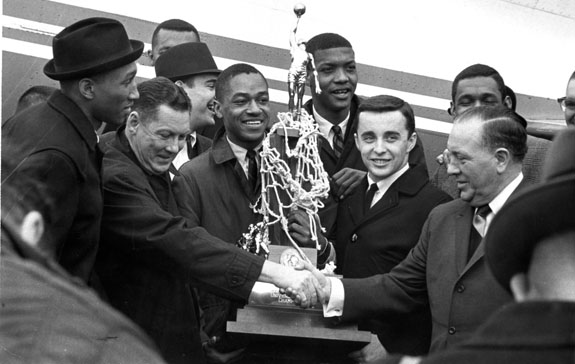
Loyola Coach George Ireland shakes hands with Chicago Mayor Richard Daley
as the team presents the National Championship trophy
|
The 2007-8 season was the best since 1986 for the Drake Bulldogs of Des Moines IA. However, the school's best season ever was 1968-9 when the Bulldogs made the Final Four. It took UCLA to eliminate them in the semifinals in the Bruins' closest game of the tournament by far.
Coach Maury John's squad compiled a 22-4 regular season record to win a share of the Missouri Valley Conference championship with Louisville. Since only the champion of the conference went to the NCAA tournament and there was no conference tournament, Drake defeated the Cardinals 77-73 in a playoff to make March Madness for the first time. A stellar freshman class from four years earlier had now matured into senior leaders: high school teammates Dolph Pulliam, the top player in Indiana, and 6'3" Willie McCarter; and 6'8" Garry Odom, a high-school All-American from St. Louis. The next year's group of recruits included 6'5" Al Williams and 6'8" Rick Wanamaker as well as JUCO transfers: 6'5" F Willie Wise and Gs Don Draper and Gary Zeller. From 9-16 in 1966-7, Drake improved to 18-8 in '67-8 to set the stage for '68-9. The Bulldogs finally earned a #11 ranking in the last AP poll of the regular season, while UPI put them 17th. Their play in the NCAA tournament showed how low those slots were. In the Midwest regional in Manhattan KS, Drake downed Texas A&M 81-63 and Colorado State 84-77 to earn a spot in the Final Four at Louisville's Freedom Hall. |
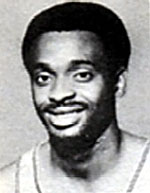 Willie McCarter |
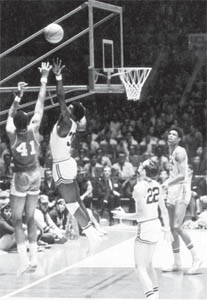 |
Awaiting them was none other than John Wooden's 27-1 #1 UCLA Bruins, seeking their third straight championship and fifth in six years. The frontline consisted of F Lynn Shackleford and F Curtis Rowe and 7'2" C Lew Alcindor. The guards were John Vallely and Henry Bibby.
However, the Bulldogs were not in the least intimidated, playing their patented "belly to belly" defense all over the court. McCarter scored 8 points in two minutes. The crowd supported the underdog all the way. In the last minute, Drake trailed by only 3. McCarter missed a shot (there was no 3-point line in those days) but Pulliam put it back with 7 seconds left. Time out. UCLA threw the ball high to the other end of the court where Alcindor outleaped everyone to grab it and toss it back toward midcourt. UCLA sank two FTs after the buzzer to make the final 85-82. One incredible stat from the game: Drake took 83 shots to UCLA's 50. McCarter scored 24 while Wise grabbed 16 (second only to Lew's 18). Afterwards, Wooden was asked what was wrong with his team? "Drake. Drake gave us as much trouble – maybe more – than any team we've ever played in the tournament." In those days, the semifinal losers played a Consolation Game before the Championship Game. Drake bombed North Carolina 104-84 with McCarter scoring 28 and Wise 16. In the final, UCLA walloped Purdue 92-65. Near the end of the game, the Bruin crowd turned to the Drake fans and chanted, "You're #2." Some Bulldog fans thought #1 1/2 was more appropriate. Maury John was selected National Coach of the Year by the Basketball Writers Association. |
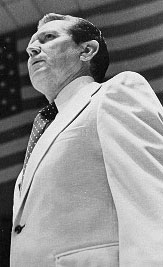
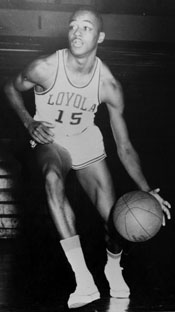
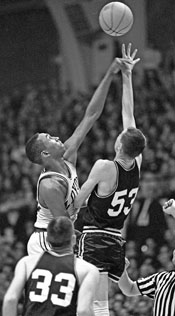
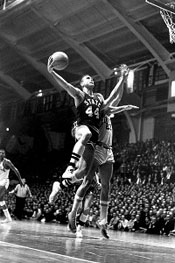
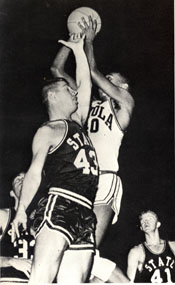

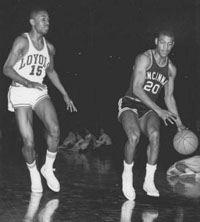 Jerry Harkness guards
xxx
Jerry Harkness guards
xxx 